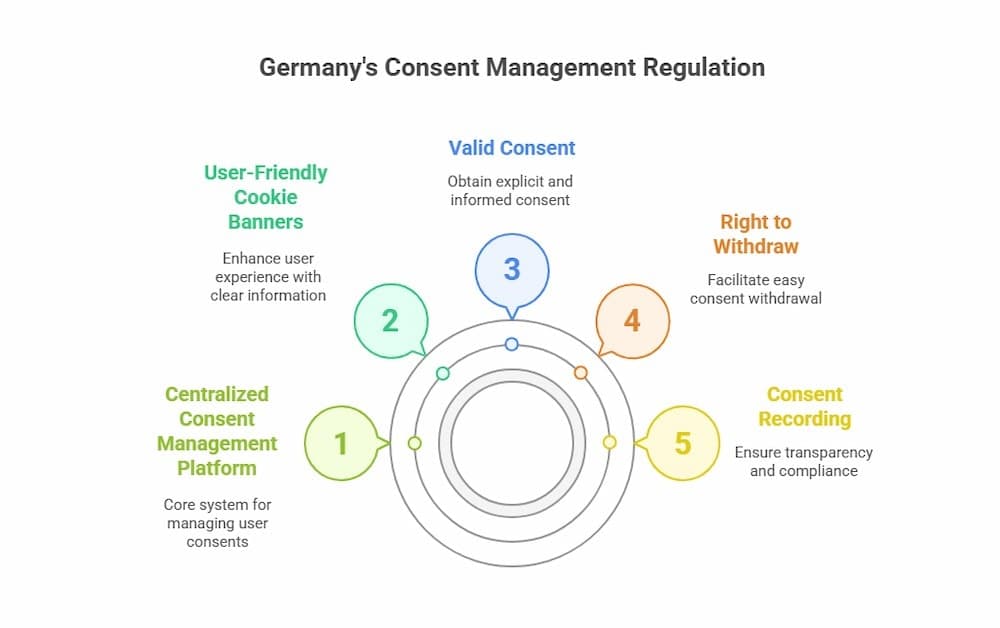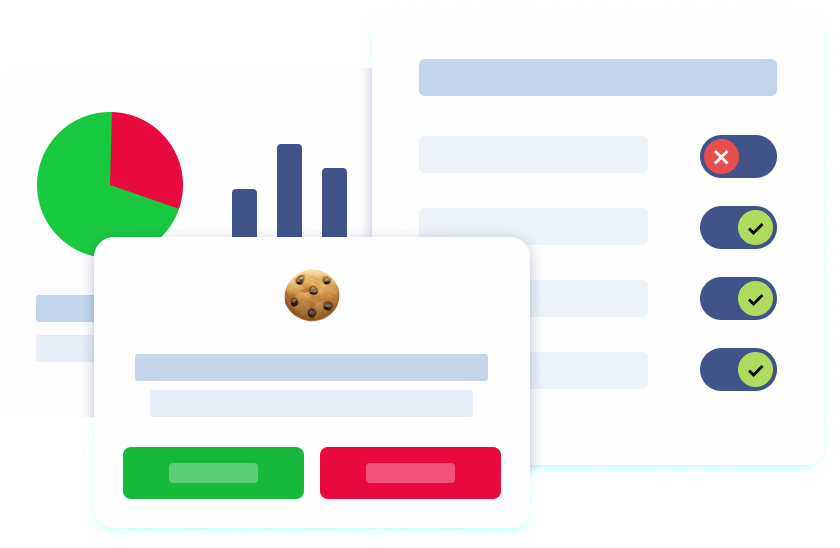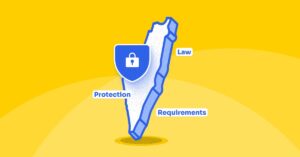Introduction
As digital interactions have become pervasive, the management of user consent for data processing has become a focal point for both regulators and website operators. Germany’s recent introduction of the one-click cookie option marks a significant stride towards enhancing data protection and streamlining consent mechanisms. This initiative is rooted in the broader framework of the General Data Protection Regulation (GDPR), aiming to bolster user privacy while simplifying the consent process.
Many websites rely on third-party tools and services, such as analytics platforms and video hosting, which increases the importance and complexity of managing user consent and privacy preferences.
The one-click solution empowers users to grant or withhold consent for cookie usage with a single action, thereby reducing the prevalence of intrusive cookie banners. For website operators, this translates to a more straightforward compliance pathway, ensuring that consent mechanisms are both user-friendly and aligned with legal requirements. By providing clear and concise information about data processing activities, websites can foster trust and transparency with their visitors.
Traditional consent management solutions often introduce more complexity, such as centralized consent services, which can hinder user experience and operational efficiency. The one-click option aims to reduce these additional layers and streamline the process.
Background and Context
The foundation of Germany’s new regulation lies in the ePrivacy Directive and the GDPR, both of which underscore the necessity of informed consent for data processing and electronic communications. These regulations mandate that users must be adequately informed about the collection and use of their personal data, particularly in the context of cookies and similar technologies.
Additionally, the German data protection act, specifically the Telecommunications Telemedia Data Protection Act (TTDSG), serves as a key legal framework for cookie and consent regulations, requiring explicit user consent for tracking technologies.
The German government’s implementation of this regulation addresses growing concerns about data protection and user privacy, especially regarding online advertising and user tracking. Website operators utilizing cookies for advertising purposes, including those leveraging third-party services like Google Analytics, are now required to adhere to stricter consent protocols. Supervisory authorities are tasked with monitoring compliance, and non-compliant website operators may face significant fines and reputational damage.
A thorough legal assessment is necessary to ensure compliance with the relevant data protection laws and directives.

Germany’s New Regulation
The new regulation introduces a centralized consent management platform, designed to allow users to manage their cookie preferences and multiple consents across different websites seamlessly. Website operators are mandated to integrate this platform into their websites, ensuring that users can easily access and adjust their consent settings.
Key features of the regulation include:
- User-Friendly Cookie Banners: Cookie banners must be designed to be intuitive and provide clear information about data processing activities. Well-designed consent banners can improve the user experience.
- Valid Consent: Website operators must obtain explicit and informed consent from users before setting non-essential cookies.
- Right to Withdraw: Users have the right to withdraw their consent at any time, and mechanisms must be in place to facilitate this process.
The platform records when users click to give or withdraw consent, ensuring transparency and compliance with data privacy laws.
By establishing these guidelines, the regulation aims to enhance user autonomy and ensure that consent is both meaningful and respected. The platform must also be able to collect consent in a manner compliant with legal requirements.
Technical Implementation
Implementing the one-click cookie option necessitates the use of a Consent Management Platform (CMP) that complies with the regulation’s requirements. The CMP must be capable of collecting, storing, and transmitting user consent preferences, as well as providing users with access to their consent settings. The CMP must also ensure that explicit user consent is obtained before setting cookies on the user’s device.
Website operators must ensure that their websites are compatible with the CMP and that user consent is accurately communicated to third-party services. Data stored on the user’s device must only be accessed after proper consent is given, and the CMP must safeguard data on the user’s device from unauthorized access. Accessing user data or cookies requires explicit, informed consent in compliance with legal standards. Data security is paramount; thus, operators are required to implement measures that safeguard user data against unauthorized access or breaches.
Legal and Regulatory Framework
The regulation is anchored in the GDPR and the ePrivacy Directive, both of which take precedence over national data protection laws in cases of conflict. Germany’s adoption of this regulation reflects a commitment to addressing the complexities of data protection and user consent in the digital age.
Under this framework, website operators must ensure their consent mechanisms are GDPR compliant. Operators must obtain consent from users before processing their data. This regulation is designed to protect the rights of the data subject under the GDPR. Supervisory authorities are empowered to enforce the regulation, and non-compliance can result in substantial fines and damage to a company’s reputation.
Google Analytics and Cookie Tracking
Google Analytics remains one of the most popular tools for monitoring website traffic and analyzing user behavior. However, its use raises important questions about cookie tracking and the collection of personal data, such as IP addresses and browsing patterns. Under the GDPR and the ePrivacy Directive, website operators must secure explicit consent from users before activating Google Analytics, as the tool processes personal data for analytics and advertising purposes.
To comply with these legal requirements, website operators must display transparent cookie banners that clearly inform users about the use of Google Analytics and the types of data collected. Users should be given a straightforward way to opt out if they do not wish to have their data processed. Additionally, operators must establish a legal basis for using Google Analytics, whether through explicit consent or, in limited cases, legitimate interests—though the latter is subject to strict interpretation by supervisory authorities.
Another critical consideration is the potential transfer of personal data to third countries, which can occur when using Google Analytics. Website operators must assess these risks and ensure that any data transfers comply with applicable data protection laws. By implementing robust consent mechanisms and providing clear information, website operators can use Google Analytics responsibly while safeguarding user privacy and maintaining compliance with the ePrivacy Directive and GDPR.
Request Consent and Cookie Consent
Requesting and managing cookie consent is a cornerstone of GDPR compliance and a vital aspect of protecting user privacy. Website operators are required to inform users about the use of cookies and the data collected, presenting this information in a clear and concise manner. This transparency enables users to make informed decisions about whether to accept or reject cookies, ensuring that any consent given is truly valid.
To obtain valid consent, website operators should use cookie banners and consent management platforms that are easy to understand and navigate. These tools help users manage their preferences and give or withdraw consent as they see fit. It is essential that operators respect users’ choices and refrain from using dark patterns or deceptive techniques to manipulate consent decisions, as such practices can lead to significant criticism and potential violations of data protection regulations.
Ultimately, the goal is to foster trust by prioritizing user privacy and providing meaningful control over data processing. By adhering to these principles and maintaining clear communication, website operators can ensure GDPR compliance, protect the data collected, and create a more user-friendly online environment.

Benefits and Advantages
The one-click cookie option offers several benefits for both website operators and users:
- Simplified Consent Management: Website operators and website owners can reduce the complexity and administrative burden associated with cookie consent, making compliance with regulations more manageable.
- Enhanced User Experience: Users are provided with a seamless and intuitive way to manage their cookie preferences.
- Improved User Privacy: The centralized consent management platform empowers users to control their data and make informed decisions about data processing.
- Increased Transparency: Website operators are required to provide clear and concise information about data processing and user tracking, fostering trust and accountability. Users also have more control over their collected data, such as information obtained through cookies or analytics tools.
These important points highlight the advantages of the one-click cookie option, including simplified compliance for website owners, enhanced user control over collected data, and improved transparency.
User Experience and Engagement
The design of the one-click cookie option is centered around improving user experience. By reducing the number of intrusive cookie banners, users can navigate websites with fewer interruptions. This regulation enhances privacy protection for internet users. Website operators must ensure that their consent mechanisms are user-friendly and accessible, providing clear information about data processing activities.
Engaging users in the consent process is crucial, as it helps ensure that user consents are meaningful and informed. Operators are encouraged to provide opportunities for users to offer feedback and exercise their rights under the GDPR. Consent mechanisms must be triggered as a user visits each page, and consent must be managed consistently across all pages of a website. Additionally, websites must be designed to be accessible and usable, ensuring a positive and engaging experience for all users.
Impact on Targeted Advertising
The regulation has significant implications for targeted advertising and personalized advertising. Website operators are now required to obtain explicit consent from users before collecting and processing their personal data for advertising purposes, and real-time bidding processes are impacted by stricter consent requirements. This may lead to a reduction in the effectiveness of targeted advertising, as users may be more hesitant to provide consent. Additionally, such tracking technologies must comply with new consent standards to ensure legal compliance.
However, the regulation also presents an opportunity for website operators to build trust with their users. The regulation limits the sharing of user data with other websites for advertising purposes, further protecting user privacy. By providing transparent and concise information about data processing and user tracking, and ensuring that only informed and explicit consent is valid under the new regulation, operators can foster a sense of trust and encourage users to provide consent. Adapting to this new regulatory environment will require innovative and user-centric approaches to targeted advertising that prioritize user privacy and consent. Privacy risks may still arise, for example, through tracking over a period of four weeks, which can potentially lead to the re-identification of users.
Conclusion
Germany’s introduction of the one-click cookie option marks a significant and noteworthy advancement in the realm of data protection and user consent management. By simplifying the consent process and enhancing user control over personal data, this regulation not only aligns with the established principles of the GDPR and the ePrivacy Directive but also sets a precedent for how privacy rights can be upheld in the digital age.
Website operators are now tasked with implementing user-friendly and compliant consent mechanisms that are easy to navigate, thus fostering transparency and building greater trust with their users. As the digital landscape continues to evolve rapidly, such regulations will play a crucial and essential role in ensuring that user privacy remains a top priority, ultimately paving the way for a safer and more secure online environment for all individuals.



